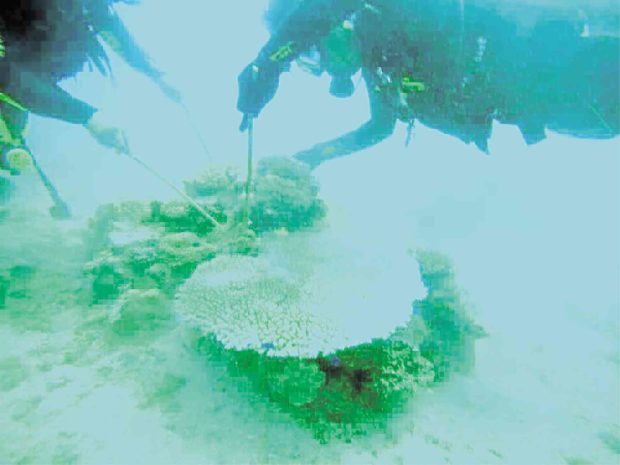Corals at risk as poisonous starfish spreads in S. Leyte waters

SAVING CORALS Members of the Ormoc Scuba Divers Club extract crown-of-thorns from coral beds in coastal villages in Malitbog, Southern Leyte. —CONTRIBUTED PHOTO
TACLOBAN CITY, Leyte, Philippines — An outbreak of the poisonous crown-of-thorns starfish has been reported in the waters off at least five towns in Southern Leyte, endangering the province’s coral beds.
Armando Gaviola of the provincial environment and natural resources management office described the “massive infestation” of the crown-of-thorns as “very alarming” as these destroyed corals.
“Supposedly, in a hectare of a coral reef, we can see [only] four to five crown-of-thorns. But now, there are even crown-of-thorns of close to a hundred per hectare seen in some coral reefs,” Gaviola said.
A class of starfish that become pests if their reproduction is not controlled, crown-of thorns destroys the habitat of fish and other marine animals.
It has venomous sharp spines that look like a crown. Crown-of-thorns is one of the largest kinds of starfish and can reach up to 20 inches in diameter. It preys on hard or branching corals.
Article continues after this advertisementHumans at risk
Article continues after this advertisementCrown-of-thorns is also dangerous to humans as its prick causes stinging pain, bleeding, nausea and swelling, which may last a week.
Gaviola could not say as to how many hectares of coral reefs had been affected by crown-of-thorns but noted that the number might be “overwhelming.”
Its presence, he said, was first noticed in the sea off the towns of Malitbog, Padre Burgos, Libangon, Liloan and Limasawa as early as May.
Gaviola said his team extracted and collected these starfish species to save local corals. The team used a specialized “gun” injected with a lime solution to kill the starfish, he said.
“We have no idea yet as to the reason why there is a surge of crown-of-thorns affecting our coral reefs. Perhaps, it could be due to climatic condition, or they were brought by the current here,” he said.
“We are alarmed by the presence of these crown-of-thorns in our seas because they are killing our corals, even the hard ones, which serve as breeding ground of our fish,” he said.
The destruction of coral reefs would hurt the tourism industry of Southern Leyte, which is popular for its diving sites, local officials said.